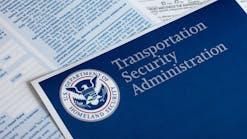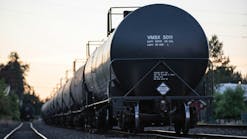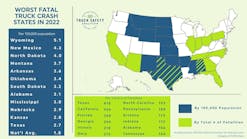Latest from Regulations
Tanknology expands fuel quality services
FMCSA to award CMV safety grants
DR Rachel A Meidl, deputy associate administrator in the Office of Hazardous Materials Safety for the Pipeline and Hazardous Materials Safety Administration (PHMSA), doesn’t know the exact nature of the budget that Congress will ultimately pass.
But based on President Trump’s “skinny budget” released in March and the revised budget released in late May—both of which proposed the elimination of the Chemical Safety Board (CSB)—she says that “certainly there will be some sort of decrease in our budget.”
Meidl was the Annual Safety Awards luncheon speaker during National Tank Truck Carriers’ 69th Annual Conference held April 30 to May 2 in Chicago, Illinois. She said that in addition to budget cuts, the agency also is facing the impacts of two executive orders from the Trump Administration:
• EO 13771: Reducing Regulation and Controlling Regulatory Costs. Issued January 30, it declares that: when an agency promulgates a new regulation, it shall identify at least two existing regulations to be repealed; for FY17, the total incremental cost of all new regulations, including repealed regulations, to be finalized this year shall be no greater than zero; and any new incremental costs associated with new regulations shall be offset by the elimination of existing costs associated with at least two prior regulations.
“So we are having to closely pull back on a lot of the rules that we did and a lot of our regulatory actions that we did, and having to re-justify some of them, which is not a bad thing in most cases,” Meidl said.
• EO 13777: Enforcing the Regulatory Reform Agenda. Issued February 24, it directs each agency to establish a regulatory reform task force and designate an agency official to evaluate existing regulations and make recommendations for improving implementation of regulatory reform initiatives and policies, and identifying regulations for repeal, replacement, or modification.
“You’ll also have an opportunity to weigh in,” she said. “If you have feedback or input on some of the duplications and the excess of government, now is your time to really weigh in and give your feedback.
“Despite the administration’s regulatory holds, we’re looking at ways we can advance the priorities we have right now. We’re operating in a difficult and challenging environment right now, with the demands continuing to grow. There are so many new energy sources. We’re looking at what that means for us in the transportation industry, what it means for production, what it means for new chemical products. So the scope of our work continues to grow. That’s a little bit of a challenge, considering the new administration and some of the budget shortfalls we have right now. What we can do is partner with you and our stakeholders.”
She said that as PHMSA works through the transition period, these are the key priorities she wants focus on:
• Invest in ourselves. “This helps maintain stability throughout changing times. I like to keep my staff engaged and motivated. It gives them a sense of dedication to what we do.”
• Increase communication internally and externally. “When I first came to PHMSA a few years ago, I noticed we were challenged with communication issues. I’m trying to engage with our stakeholders. I think that helps us maintain a level of control and equanimity and alleviate a lot of misconceptions that are out there.”
• Position ourselves for innovation. “There’s a lot of new technology out there, and I’m trying to embrace that and change the mindset in the agency to be truly results-driven and data-driven, and to drive our decisions based off of that. It’s a different culture, but we’re getting there.”
• Foster transparency. “It’s difficult for us as an agency, especially in a time of transition, to really communicate exactly what’s happening when things are changing by the minute and by the day. There are a lot of new executive orders that have a lot of implications for what we do, so we’re trying to be as transparent as possible to create that trust with you.”
• Improve engagement. “Not just with you, but with all partners and stakeholders. It’s so important for us to bring you all into the decision-making process instead of trying on our own to figure out what these new executive orders mean. Engaging with you and bringing you into the process is really going to help us, and it’s analogous to both of our safety missions.”
Meidl said that data and information that PHMSA collects has informed the agency’s actions. It can help drive policy decisions on how the agency is going to regulate and enforce.
But she thinks “that should be the last thing we do. It should help us identify where we can partner with the industry, where there are opportunities to invest and to educate. Our data isn’t perfect. We’re reconfiguring how we look at data. I’m a very data-driven person. When I first came to the agency, I was little bit horrified about how we were releasing our data and how we had so much of it. We were data-rich and information-poor. I challenged our group to look at the data we collect. Is it the right data? What are we doing with that data? What does it mean? How is it driving our decisions? It’s important to make sure that the decisions we’re making are being driven based off the right data.”
Addressing cargo tank rollovers, she said that in 2016, over 30% of hazmat incidents involving death or major injury resulted from rollovers, with gasoline being the main commodity. The Federal Motor Carrier Safety Administration (FMCSA) indicated that 78% of rollovers involved driver factors: sudden maneuvers, braking, and excessive speed.
PHMSA and FMCSA are analyzing a human factors study on rollover prevention.
“The approach we’re taking with this is, ‘What do drivers and safety directors and safety programs do? What do they entail? What do they do on a day-to-day basis that allows for the million-mile-plus accident-free drivers?’ FMCSA has reached out to NTTC to host a roundtable. And we’ve embarked on a number of initiatives to address rollovers.”
Outreach and prevention initiatives:
• Cargo Tank Rollover Prevention video: jointly produced by PHMSA, FMCSA, and the industry.
• Hazmat Transportation Training Modules: general awareness training available through a link on the PHMSA website.
• FMCSA provides useful reports, brochures, and other resources in its Cargo Tank Rollover Prevention toolbox.
PHMSA has been investigating a number of unloading and loading incidents involving incompatible materials. The poster child appears to be an incident in Atchison, Kansas, in 2016 involving an accidental mixing of sodium hypochlorite with sulfuric acid. The plume generated by the chemical reaction led to a shelter-in-place order for thousands of residents. At least 120 employees and members of the public sought medical attention.
In April, the CSB released preliminary findings indicating that there was “unclear labeling of fill lines—an engineering flaw of having the fill lines of incompatibles so close.”
“Events like this serve to remind us in the industry to review chemical unloading procedures and to make sure chemicals are unloaded safely and follow standard operating procedures,” Meidl said. “We worked hand-in-hand with the Chemical Safety Board. They asked a number of different questions: ‘What types of events trigger PHMSA’s involvement when trucks are unloading chemicals at fixed facilities? If a company’s SOP (standard operating procedure) is compliant with the attendance requirement, but the employee did not follow it, can/would DOT still cite the company? Is it common for chemical delivery companies to have site-specific procedures for unloading chemicals at specific facilities, or general procedures that apply to all facilities where chemicals are unloaded?’
“I said with a lot of these questions, you should really be talking to the regulated community, to folks like yourselves, because a lot of these questions were very much operational, and you’ve lived this every single day and would know the answers better than we would, especially in the area of precautions being taken at chemical facilities. I work with NTSB and CSB and I always recommend speaking to the community. Get their feedback. So we’ll continue exploring a lot of these incidents, but it would certainly be beneficial to collaborate with you to define solutions to these recurrent problems.”
For Cargo Tank Motor Vehicle (CTMV) loading/unloading operations, there is a 2014 recommended best practices guide that suggests: identifying the piping path, equipment lineups, and operational sequencing and procedures for connecting piping, hoses, or other transfer connections; and verifying that the material is being transferred into the appropriate receiving container, and that the container, and its contents, are compatible with the lading and has sufficient capacity to hold the quantity of material being transferred.
She said the Protecting Our Infrastructure of Pipelines and Enhancing Safety (PIPES) Act of 2016 has created some “consternation” with the PIPES Act Requirements for Identification Numbers on Cargo Tanks Containing Petroleum Based Fuel.
“PHMSA currently is weighing the 13 comments to the docket to determine the next steps,” she said. “We’re trying to determine the best path forward. But the initial assessment, just looking it contextually, is that the current HMR already allows for compartmented cargo tanks containing diesel in one compartment and gasoline in another. This petition asks us to expand on an already flexible system that authorizes something that’s completely different. We are considering the implications of this.”
She said that with the regulatory freeze and the new executive orders, PHMSA has to take another look at a lot of its regulations.
“When Trump pushed out his executive order, he used the term ‘regulation’ very broadly, so I guess if you want to call it the regulatory or statutory or whatever, as an agency we interpreted that very broadly to mean anything that triggers the regulation,” she said. “So we kind of had to put a hold on petitions, special permits, rulemakings, and decisions we had to make in order for us to wait for clarification from the White House on what that meant.
“We are still moving with our safety mission. And since the regulatory freeze is still in place, we have kicked things down the pipeline and we are continuing to push things out. So we’ve got our own internal interpretation of what that is. But I’m just saying for you to be aware that if you see a slowdown in things, it’s because of the regulatory freeze coupled with the hiring freeze. But we have prioritized those issues and rulemakings and petitions that are considered high priority.”
She presented the NTTC’s open petitions and interpretations:
• Petition to amend 180.405(h)(3). It would add language to harmonize with packaging specifications and preclude use of fusible devices on MC307 when DOT407-compliant vent is installed.
“We decided it merits consideration for future rulemaking, so we are sending out a letter on that,” she said.
• Interpretation No. 16-0001. The request for clarification is:
“The required markings must be on the inlet and outlet equipment itself and in close proximity to its respective make/break connection point, rather than on the cargo tank wall.”
“We recognize that it’s pretty broad and we are in the process of drafting a response to clarify existing clarification,” she said.
She said there is recent proposed rulemaking in the form of HM-241: Adoption and IBR of ASME Section XII into the HMR.
“Current requirements for pressure vessels in transportation include ASME Section VIII,” she said. “This is for stationary applications in stationary tanks. So ASME Section XII, developed by the industry along with PHMSA engineers, takes into account the dynamic stresses in transportation. So this standard would allow manufacturers to take advantage of lower priced/lighter weight tank materials, reduce manufacturing costs, and better compete internationally. Shippers would be able to transport more material per tank, reducing overall transportation costs. A regulatory analysis is being updated and a Final Rule drafted.” ♦










